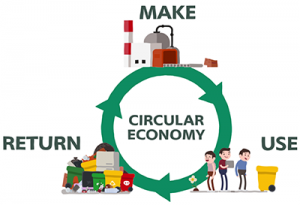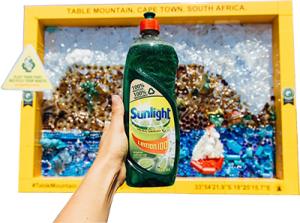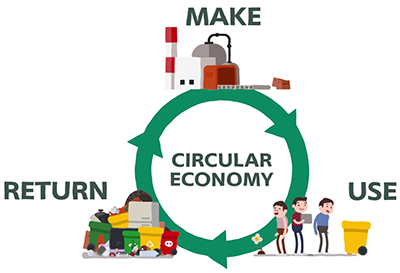Packaging material is becoming a large source of waste and there’s an urgent need reduce the impact on the environment. Circular Economy is the way forward. A Packaging MEA report on how to go about adopting it
 To “Begin with the End in Mind” is what Circular Economy is all about. It involves planning and considering a product’s “after life” so that it can be recycled into a useful product. It calls for designing the waste out at the product’s initial stage. This is very true for the packaging industry as well where designing and creating the pack to be able to recycle it into a useful product is a good approach towards a circular economy.
To “Begin with the End in Mind” is what Circular Economy is all about. It involves planning and considering a product’s “after life” so that it can be recycled into a useful product. It calls for designing the waste out at the product’s initial stage. This is very true for the packaging industry as well where designing and creating the pack to be able to recycle it into a useful product is a good approach towards a circular economy.
Need for a circular approach
In a circular economy, products and materials keep circulating in a high value state of use, through supply chains, for as long as possible. With increasing demand for raw materials, there is an ever increasing burden on the environment and serious danger of climate change, shortage of raw materials and damaged biodiversity. On the other hand transitioning to a circular economy offers opportunities, besides preserving the environment. It creates jobs and businesses through innovation, design, recycling and creativity.
Currently, large amounts of packaging waste escape formal collection and recycling systems and eventually end up polluting the environment, while their material value is forever lost to the economy. So how can we improve packaging systems in order to capture this wasted potential? Clearly, the way we currently design, recover and reuse packaging urgently needs a rethink.
In contrast to our current industrial model, which extracts, uses and disposes of resources, a circular economy is regenerative by design. This means that products and their packaging are reimagined and redesigned from a systems perspective.
Communicating the Need to find Solutions
Producers want to ensure their packaging decisions to meet consumer demands for performance, cost savings and sustainability but also that they do not have unintended consequences. Waste managers want to ensure that they are able to economically recover as many materials as possible while providing a valuable service to residents of a municipality. Disjointed communication between packaging producers, consumers and waste management companies leads to frustration between stakeholders, delaying opportunities to progress innovative solutions.
Understanding how packaging can be diverted from landfill and avoid becoming waste is undoubtedly complex. When the answer to the question ‘Can this packaging be recycled?’ is unsure, the packaging industry and stakeholders along its value chain is left with insufficient information. Solutions are needed to address today’s top packaging challenges to avoid waste. This means bridging the gap between stakeholders is a step towards sustainable packaging. A good example of this is the recently signed pledge by the Coalition CIRCLE (Coalition of Innovation in Recycling towards a Closed Loop Economy) – a newly formed coalition comprising the UAE government’s Ministry of Climate change, NGO’s and global and local private companies. The pledge is aimed at transforming packaging recycling infrastructure in the UAE towards a circular economy. The PRIME Summit 2019 at Conrad Dubai on the 10-11 September 2019, organised by Packaging MEA is another major step towards changing the region’s packaging sustainability goals to a more circular approach.

The brand owner’s take
We’re in a society that’s far more motivated than previous generations to consider the health and environmental consequences of our consumption habits. Today’s “aspirational” generation of consumer that represents 40% of the global adult population is, according to research, a group who prefer experiences over products and authenticity over perfection and this group uses their consumption to drive big brands into the causes they believe in. Most of the big brands like Mars, Mondelez, PepsiCo, The Coca Cola Co, Nestlé and others are working towards making all their packaging 100% recyclable at the earliest. Unilever has announced its commitment to help encourage more plastic packaging materials back into the value chain after use by ensuring all its packaging is reusable, recyclable and compostable by 2025.
New Packaging materials and formats
Speaking of plastics, there is now a desperate need to look out for new and innovative materials and formats that can help in a closed loop recycling process. Factors like food safety and costs versus benefits have to be considered. Innovative and effective use of raw materials can create new sources of value to the consumer.
Conclusion
Moving our region’s packaging towards a circular approach needs proper communication through a common platform between stakeholders of the supply chain along with government initiatives. Thorough research on consumer acceptance of newer materials and packaging needs to be performed. Well-communicated objectives as well as engagement and willingness to accommodate needs of other stakeholders are critical factors to game-changing packaging sustainability. Packaging MEA is committed to this dire need of the hour and the PRIME Summit 2019 has a dedicated session for this topic where the industry’s stakeholders will gather to brainstorm and network in pursuit of innovative solutions.
To join the team, register at: www.prime.packagingmea.com



